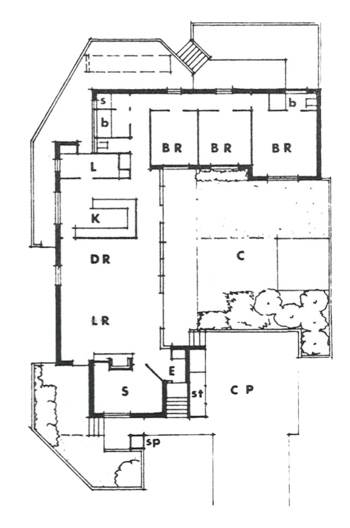Swinger Hill Stage 1 and 2, Barnet Close, Phillip (1969)
Swinger Hill Stage 1 and 2 was designed by prominent Sydney architects Ian McKay and Partners for the National Capital Development Commission (NCDC) as a prototype to test medium density design principles and as a demonstration project for private developers, who would later complete the Swinger Hill development. The first two courts in Barnet Close totalled 39 houses, arranged in small courts of 15 and 24, designed around a private car and entrance courtyard. The supervising architect was A. J. (Bert) Read.
Bert Read saw the inspiration of Swinger Hill in the hill villages of Greece or Italy or Japan, where the rows of houses, generally built of the one material, appear to belong to that one site and to no other:
Far from being monotonous, this deliberate carrying through of the one material provides a universe in small scale in which man and his environment are at one.
Swinger Hill Stage 1 and 2 was one of the first modern and appealing medium density developments in Australia to achieve a population density of 40 people per acre. It did so in a way that gained wide public acceptance, contrary to general housing expectations at the time and hostility from sections of the Department of the Interior. The houses were awarded the C. S. Daley Medal in 1977.
The Barnet Close group is a good example of the Sydney regional style of architecture. They form a consistent group, unified by the careful selection of materials, colours, detailing and landscaping. The overall quality and siting of this first group is outstanding when compared to the houses later developed and built by private contractors elsewhere in Swinger Hill.
Swinger Hill Stage 1 and 2 is listed on the ACT Chapter of the Australian Institute of Architects (AIA) Register of Significant Twentieth Century Architecture. The development is regarded by the AIA as being important as a social and historical landmark and being an innovative design solution.
Description
In developing its plans for medium-density development at Swinger Hill and other areas of Canberra, the NCDC sought to define a number of housing types, three of which were used, in various guises, in Stage 1 and 2 of Swinger Hill: the courtyard house, the atrium house and the terrace house.
The courtyard house was a single level dwelling with two courtyards: a service court and a recreational court. They were usually an L-shaped plan, forming two sides of a courtyard. There are 22 courtyard houses in Barnet Close.
An example of narrow housing, the atrium house was a single level, rectangular dwelling with three courtyards: one at either end and an atrium court in the centre—living rooms look out to the atrium court. There are four atrium houses in Barnet Close.

Courthouse CH3 floorplan
The terrace house was two storey, either in a small cluster of three, or freestanding. In Barnet Close these typically have a service court entry and a north or north east facing recreational courtyard. There are 13 terrace houses in the Barnet Close group.
The houses were of brick veneer construction with hardwood framing and select commons bricks from Bowral. The soft brown bricks were used for all external walls, for garden and courtyard walls, and for a number of internal walls. The brickwork was laid with flush joints to emphasise the mass of the walls.
Service piers for each house are also of brick, with precast concrete elements used to emphasise functional purpose. Each pier had four separate compartments: for the meter box; bread and milk deliveries; mail; and for the concealed storage of a garbage can. The roofs were of charcoal brown concrete tiles. Natural finish timbers were used on the exterior.
As far as possible the houses were designed to integrate the outdoors with the indoors. The garden courts, paved in brick, are on the same level as the living room floors, to avoid the sense of division created by a change in level. Exposed timber beams give emphasis to the sloping roofline in most main living areas.
The urban planning of the Barnet Close group is of particular interest. The internal road design, with a series of courts and ramps set at various levels, eliminates through traffic from each section, reduces the total amount of traffic movement and keeps vehicle speeds down. The siting of neighbouring houses is planned so that no house has a window facing another, unless there is a walled courtyard in between. Careful siting ensures that each house has more privacy than in detached suburban housing. Each house has an enclosed service court as well as an enclosed garden court. Where two houses adjoin, they are separated by a double brick cavity wall.
NCDC display village
The NCDC opened five of the first 39 houses over two weekends in April 1972 to gauge public interest. Four of the five houses were presented fully furnished by local businesses. These five display houses were larger and more elaborate versions of the housing types (described above) present throughout the remainder of Stage 1 and 2 of Barnet Close.
- A two storey terrace house with three bedrooms
- A three bedroom atrium house, designed so living areas look out onto a central courtyard.
- A three bedroom L-shaped courtyard house
- A four bedroom courtyard house, with all rooms looking out to a garden courtyard.
- A three bedroom courtyard house with a study
On the weekend of 8 and 9 April 1972, 11,000 people attended the exhibition. The following weekend 8,500 attended, making it the most successful project ever launched by the NCDC.
Source
- Australian Institute of Architects RSTCA citation No. 49
- Ian McKay, Robin Boyd, Hugh Stretton and John Mant, Living and Partly Living: Housing in Australia, Nelson, 1971
- ‘$670,000 project open to the public’, Canberra Times, 7 April 1972, pp 9-11



